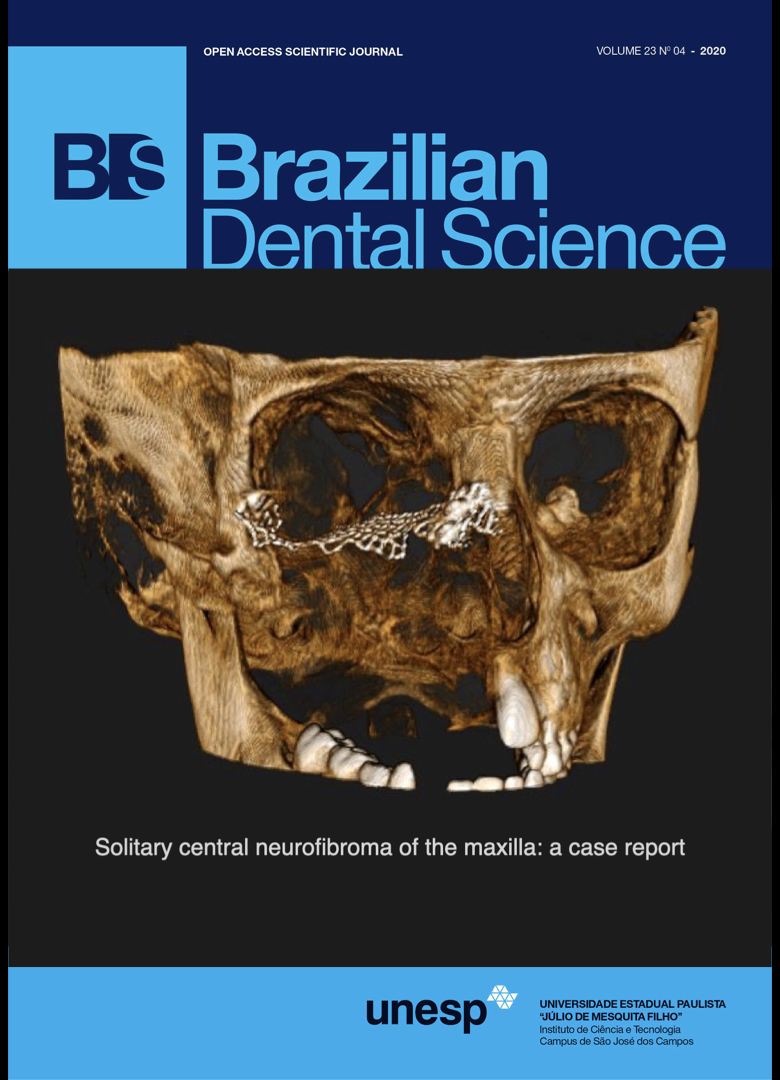Pictograph system for diagnosis making and data management in endodontics
DOI:
https://doi.org/10.14295/bds.2020.v23i4.2056Abstract
ABSTRACT
Objective: this questionnaire aimed to evaluate the approval of a new pictograph system for endodontic diagnosis by undergraduate and graduate students/endodontist instead of a conventional method. Methods: after a presentation to a total of 224 participants explaining the pictograph system, the participants (166 undergraduate students and 58 graduate students/endodontist) received a standardized questionnaire with three questions. The data were analyzed using the multprop macro basing on Tukey's test for multiple comparison with (P ? 0.05). The first question was to define the education level of the participants; the second question about which diagnosis method is preferred; and the third question about the intention of using one of the methods in the future. The questionnaire was realized in May 2019. The response rate was 97.7%. Results: the first question showed that 74.10% and 25.90% were undergraduate and graduate students/endodontist respectively. After statistical analysis there was no significant difference between the groups in the second and the third questions. In the second question (71.08% and 62.06%) of undergraduate and graduate student/endodontists respectively preferred the pictograph method over the conventional method. In the third question (60.24% and 51.72%) of undergraduate and graduate student/endodontists respectively showed interest in using the pictograph method in their professional career. Conclusion: the pictograph method in endodontic diagnosis is accepted by the majority of undergraduate and graduate students/endodontists. Training and experience affect the diagnosis making.
KEYWORDS
Advanced dental education; Continuing dental education; Endodontics; Pictograph
Downloads
References
Torabinejad M, Goodacre CJ. Endodontic or dental implant therapy: the factors affecting treatment planning. J Am Dent Assoc. 2006;137(7):973‐1028. doi:10.14219/jada.archive.2006.0318.
McCaul LK, McHugh S, Saunders WP. The influence of specialty training and experience on decision making in endodontic diagnosis and treatment planning. Int Endod J. 2001 Dec;34(8):594–606. doi: 10.1046/j.1365-2591.2001.00433.x.
Wenteler GL, Sathorn C, Parashos P. Factors influencing root canal retreatment strategies by general practitioners and specialists in Australia. Int Endod J. 2015 May;48(5):417–27. doi: 10.1111/iej.12330.
Zitzmann NU, Krastl G, Hecker H, Walter C, Waltimo T, Weiger R. Strategic considerations in treatment planning: Deciding when to treat, extract, or replace a questionable tooth. J Prosthet Dent. 2010 Aug;104(2):80–91. doi: 10.1016/S0022-3913(10)60096-0.
Pagonis TC, Fong CD, Hasselgren G. Retreatment decisions--a comparison between general practitioners and endodontic postgraduates. J Endod. 2000;26(4):240‐1. doi:10.1097/00004770-200004000-00012
Dechouniotis G, Petridis XM, Georgopoulou MK. Influence of specialty training and experience on endodontic decision making. J Endod. 2010;36(7):1130‐4. doi:10.1016/j.joen.2010.03.023.
Rodríguez G, Abella F, Durán-Sindreu F, Patel S, Roig M. Influence of cone-beam computed tomography in clinical decision making among specialists. J Endod. 2017;43(2):194‐9. doi:10.1016/j.joen.2016.10.012.
Azarpazhooh A, Dao T, Ungar WJ, Da Costa J, Figueiredo R, Krahn M, et al. Patients' values related to treatment options for teeth with apical periodontitis. J Endod. 2016;42(3):365‐70. doi:10.1016/j.joen.2015.11.022.
Aminoshariae A, Teich S, Heima M, Kulild JC. The role of insurance and training in dental decision making. J Endod. 2014;40(8):1082‐6. doi:10.1016/j.joen.2014.05.007.
Kvist T, Heden G, Reit C. Endodontic retreatment strategies used by general dental practitioners. Oral Surg Oral Med Oral Pathol Oral Radiol Endod. 2004;97(4):502‐7. doi:10.1016/j.tripleo.2003.09.006.
Evans N, Hayes J. Textbook of Endodontology. Int Endod J. 2005 Dec;38(12):949. doi: 10.1111/j.1365-2591.2005.01039.x.
Inquimbert C, Tramini P, Romieu O, Giraudeau N. Pedagogical evaluation of digital technology to enhance dental student learning. Eur J Dent. 2019;13(1):53‐7. doi:10.1055/s-0039-1688526.
Gramling R, Anthony D, Frierson G, Bowen D. The cancer worry chart: a single-item screening measure of worry about developing breast cancer. Psychooncology. 2007;16(6):593‐7. doi:10.1002/pon.1128.
de Boer IR, Wesselink PR, Vervoorn JM. The creation of virtual teeth with and without tooth pathology for a virtual learning environment in dental education. Eur J Dent Educ. 2013;17(4):191‐7. doi:10.1111/eje.12027.
de Oliveira MLB, Verner FS, Kamburogğlu K, Silva JNN, Junqueira RB. Effectiveness of using a mobile app to improve dental students' ability to identify endodontic complications from periapical radiographs. J Dent Educ. 2019;83(9):1092‐9. doi:10.21815/JDE.019.099.
Ben‐Moshe L, Powell JJW. Sign of our times? Revis(it)ing the international symbol of access. Disabil Soc. 2007 Aug 31;22(5):489–505. doi: 10.1080/09687590701427602.
Abu Hasna A, Ferrari CH, Bittencourt TS, Camargo CHR, Carvalho CAT. Acting and knowledge of emergency rescue teams in dental trauma. Brazilian Dent Sci. 2019 Jul 30;22(3):329–34. doi: 10.14295/bds.2019.v22i3.1717.
Usher-Smith JA, Masson G, Mills K, Sharp SJ, Sutton S, Klein WMP, et al. A randomised controlled trial of the effect of providing online risk information and lifestyle advice for the most common preventable cancers: study protocol. BMC Public Health. 2018 Dec 26;18(1):796. doi: 10.1186/s12889-018-5712-2.
Kreuzmair C, Siegrist M, Keller C. Does iconicity in pictographs matter? the influence of iconicity and numeracy on information processing, decision making, and liking in an eye-tracking study. Risk Anal. 2017;37(3):546‐56. doi:10.1111/risa.12623.
Hamasaki T, Kato H, Kumagai T, Hagihara A. Association between dentist-dental hygienist communication and dental treatment outcomes. Health Commun. 2017;32(3):288‐97. doi:10.1080/10410236.2016.1138376.
Pineda K, Bueno R, Alvarado C, Abella F, Roig M, Duran-Sindreu F. Influence of academic training in endodontics and implantology on decision-making in undergraduate students. Aust Endod J. 2018;44(1):40‐5. doi:10.1111/aej.12208.
Barstow BA, Vice J, Bowman S, Mehta T, Kringen S, Axelson P, et al. Examining perceptions of existing and newly created accessibility symbols. Disabil Health J. 2019;12(2):180‐6. doi:10.1016/j.dhjo.2018.11.012.
Downloads
Published
How to Cite
Issue
Section
License
Brazilian Dental Science uses the Creative Commons (CC-BY 4.0) license, thus preserving the integrity of articles in an open access environment. The journal allows the author to retain publishing rights without restrictions.
=================




























